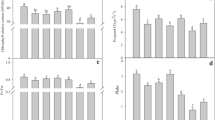Abstract
Ionol (BHT), a compound having antioxidant activity, at concentrations in the range 1-50 mg/liter (0.45·10-5-2.27·10-4 M), inhibits growth of etiolated wheat seedlings, changes the morphology of their organs, prolongs the coleoptile life span, and prevents the appearance of specific features of aging and apoptosis in plants. In particular, BHT prevents the age-dependent decrease in total DNA content, apoptotic internucleosomal fragmentation of nuclear DNA, appearance in the cell vac-uole of specific vesicles with active mitochondria intensively producing mtDNA, and formation of heavy mitochondrial DNA (ρ = 1.718 g/cm3) in coleoptiles of etiolated wheat seedlings. BHT induces large structural changes in the organization of all cellular organelles (nucleus, mitochondria, plastids, Golgi apparatus, endocytoplasmic reticulum) and the formation of new unusual membrane structures in the cytoplasm. BHT distorts the division of nuclei and cells, and this results in the appearance of multi-bladed polyploid nuclei and multinuclear cells. In roots of etiolated wheat seedlings, BHT induces intensive synthesis of pigments, presumably carotenoids, and the differentiation of plastids with formation of chloro- or chromoplasts. The observed multiple effects of BHT are due to its antioxidative properties (the structural BHT analog 3,5-di-tert-butyltoluene is physiologically inert; it has no effect similar to that of BHT). Therefore, the reactive oxygen species (ROS) controlled by BHT seem to trigger apoptosis and the structural reorganization of the cytoplasm in the apoptotic cell with formation of specific vac-uolar vesicles that contain active mitochondria intensively producing mtDNA. Thus, the inactivation of ROS by BHT may be responsible for the observed changes in the structure of all the mentioned cellular organelles. This corresponds to the idea that ROS control apoptosis and mitosis including formation of cell wall, and they are powerful secondary messengers that regulate dif-ferentiation of plastids and the Golgi apparatus in plants.
Similar content being viewed by others
REFERENCES
Scandalios, J. G. (1993) Plant Physiol., 101, 7-12.
Jabs, T. (1999) Biochem. Pharmacol., 57, 231-245.
Reichheld, J. P., Vernoux, T., Lardon, F., van Montagu, M., and Inze, D. (1999) Plant J., 17, 647-656.
Lorget, F., Kamel, S., Mentaverri, R., Wattel, A., Naassila, M., Maamer, M., and Brazier, M. (2000) Biochem. Biophys. Res. Commun., 268, 899-903.
Shorning, B. Yu., Smirnova, E. G., Yaguzhinsky, L. S., and Vanyushin, B. F. (2000) Biochemistry (Moscow), 65, 1357-1361.
Leshem, Y. Y. (1988) Free Radic. Biol. Med., 5, 39-49.
Vanyushin, B. F. (2001) Usp. Biol. Khim., 41, 3-38.
Harman, D., and Piette, L. H. J. (1966) J. Gerontol., 21, 560-565.
Emanuel, N. M. (1976) Q. Rev. Biophys., 9, 283-308.
Sharma, S. P., and Wadhwa, R. (1983) Mech. Ageing Dev., 23, 67-71.
Lippman, R. D. (1981) J. Gerontol., 36, 550-557.
Alekperov, U. K., Abutalybov, M. G., and Bagirova, A. D. (1976) Genetika, 12, 47-50.
Alekperov, U. K., Abutalybov, M. G., and Askerov, I. T. (1975) Tsitologiya, 17, 101-103.
Shorning, B. Yu., Poleshchuk, S. V., Gorbatenko, I. Yu., and Vanyushin, B. F. (1999) Izv. RAN. Ser. Biol., No. 1, 30-38.
Spirin, A. S. (1958) Biokhimiya, 23, 656-661.
Kirnos, M. D., Aleksandrushkina, N. I., and Vanyushin, B. F. (1981) Biokhimiya, 46, 1458-1474.
Kirnos, M. D., Bakeeva, L. E., Volkova, S. A., Ganicheva, N. I., and Vanyushin, B. F. (1983) Biokhimiya, 48, 1505-1512.
Kirnos, M. D., Volkova, S. A., Ganicheva, N. I., Kudryashova, I. B., and Vanyushin, B. F. (1983) Biokhimiya, 48, 1587-1595.
Kirnos, M. D., Aleksandrushkina, N. I., and Vanyushin, B. F. (1997) Biochemistry (Moscow), 62, 1008-1014 (Russ.).
Kirnos, M. D., Aleksandrushkina, N. I., Shorning, B. Yu., Kudryashova, I. B., and Vanyushin, B. F. (1999) Fiziol. Rast., 46, 48-57.
Kirnos, M. D., Alexandrushkina, N. I., Zagorskaya, G. Ya., Kireev, I. I., and Vanyushin, B. F. (1992) FEBS Lett., 298, 109-112.
Kirnos, M. D., Aleksandrushkina, N. I., Shorning, B. Yu., Bubenshchikova, S. N., and Vanyushin, B. F. (1997) Biochemistry (Moscow), 62, 1587-1597 (Russ.).
Kirnos, M. D., Aleksandrushkina, N. I., Goremykin, V. V., Kudryashova, I. B., and Vanyushin, B. F. (1992) Biokhimiya, 57, 1566-1573.
Vanyushin, B. F., Alexandrushkina, N. I., and Kirnos, M. D. (1988) FEBS Lett., 233, 397-399.
Kirnos, M. D., Aleksandrushkina, N. I., Bakeeva, L. E., Kazimirchyuk, S. B., Shorning, B. Yu., Alekseeva, V. A., Yaguzhinsky, L. S., and Vanyushin, B. F. (1999) Biochemistry (Moscow), 64, 307-317.
Bakeeva, L. E., Kirnos, M. D., Aleksandrushkina, N. I., Kazimirchyuk, S. B., Shorning, B. Yu., Zamyatnina, V. A., Yaguzhinsky, L. S., and Vanyushin, B. F. (1999) FEBS Lett., 457, 122-125.
Romanenko, E. B., Palmina, N. P., and Vanyushin, B. F. (1979) Biokhimiya, 44, 1754-1761.
Yen, C. H., and Yang, C. H. (1998) Plant Cell Physiol., 39, 922-927.
Nooden, L. D., Guiamet, J. J., and John, I. (1997) Physiologia Plantarum, 101, 746-753.
Novgorodov, S. A., Gudz, T. I., Mor, Yu. E., Goncharenko, E. N., and Yaguzhinsky, L. S. (1989) Biokhimiya, 54, 206-212.
Balk, J., Leaver, C. J., and McCabe, P. F. (1999) FEBS Lett., 463, 151-154.
Bouvier, F., Backhaus, R. A., and Camara, B. (1998) J. Biol. Chem., 273, 30651-30659.
Author information
Authors and Affiliations
Rights and permissions
About this article
Cite this article
Bakeeva, L.E., Zamyatnina, V.A., Shorning, B.Y. et al. Effect of the Antioxidant Ionol (BHT) on Growth and Development of Etiolated Wheat Seedlings: Control of Apoptosis, Cell Division, Organelle Ultrastructure, and Plastid Differentiation. Biochemistry (Moscow) 66, 850–859 (2001). https://doi.org/10.1023/A:1011996517746
Issue Date:
DOI: https://doi.org/10.1023/A:1011996517746



